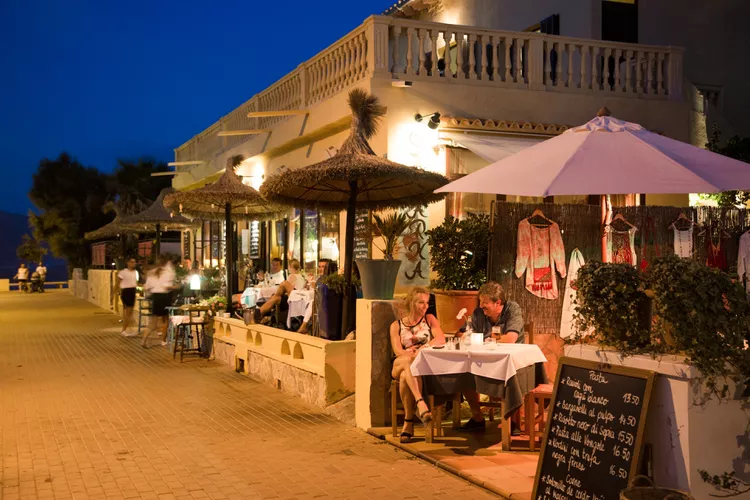1. Overview of Eating and Drinking in Spain
The cuisine of Spain is one of the most famous parts of Spanish culture. People come to Spain (particularly to San Sebastian and Seville) with food as the main lure.
2. When to Eat and Drink in Spain
The Spanish eat late, particularly at dinner time, with a long gap between lunch and dinner that is broken up by merienda, similar to a second breakfast. Therefore, getting on Spanish time will help avoid eating in an empty restaurant.
3. A Day of Eating and Drinking in Spain
- 8:30am Start with a light breakfast. Usually, a coffee and a pastry or, for those with a sweet tooth, chocolate con churros.
- 12:30pm You’re on vacation! So indulge in La hora del vermut – roughly translated as ‘vermouth o’clock’, the traditional pre-lunch sipping of a Spanish sweet vermouth which has recently made a comeback.
- 1:30pm For lunch, most people go for a menu del dia, a good value set meal that most restaurants offer.
- 5pm If lunch wasn’t big enough, stop for merienda.
- 9pm Time for tapas! Learn to do tapas the proper way.
- 10pm Though tapas can be a meal in itself, you might prefer a proper sit-down dinner. However, there are things you ought to know about dinner in Spain.
- 11.15pm There’s more! Check out the post-dinner digestif.
- 11:20pm It’s time to pay the bill. Should you tip?
- 11:30pm Feeling buzzed after your coffee? There’s no need to stop – the Gin and Tonic is now the ubiquitous drink that you need to try Spanish style!
4. Breakfast in Spain
The Spanish breakfast is short, sharp, and to the point, providing a quick injection of caffeine, sugar, and/or alcohol to get you through the morning.
5. What to Drink for Breakfast in Spain
- Coffee: Ordering ‘un café‘ will get you café con leche, while a ‘cortado‘ has less milk, and ‘café solo‘ is a straight espresso.
- Chocolate and Cola Cao: A thick melted down pure chocolate drink for dunking churros or a hot chocolate milk available in any cafe in Spain.
- Fresh Orange Juice: Always freshly squeezed, usually pushing the price of breakfast higher.
- Beer: Surprisingly common for breakfast, with some special offers including ‘beer and tortilla’.
- Brandy: A drink often enjoyed by older gentlemen.
6. What to Eat for Breakfast in Spain
- Croissant or other pastry: French-style sweet pastries like napolitana (pain au chocolate) are popular.
- Tostada: Toast typically served with marmalade, jam, ham, cheese, or tomato and olive oil.
- Tortilla: Paired with a beer!
- Torrijas: Spain’s version of bread pudding or French toast, a must-try if available.
7. Where to Have Breakfast in Spain
Unless there’s a specific coffee roastery or churros maker you want to visit, choose a place with a good view. A meal on the Ramblas in Barcelona or Plaza Mayor in Madrid might be overpriced but offers a fantastic view of famous sights.
8. La Hora del Vermut – Vermouth O’Clock!
Before productivity became a measuring tool, a pre-lunch drink to whet the appetite was essential. In cities like Madrid and Barcelona, La hora del vermut (‘vermouth hour’) is a classic lunchtime activity returning to popularity.
9. Best Place to Drink Vermouth in Spain
Explore the vermuterias in the Gracia district of Barcelona for authentic experiences.
10. Lunch (Menu del Dia)
Your best option for lunch is a menu del dia, a three-course meal that’s cheaper than ordering separately and is great for solo travelers. Meals typically consist of a first course, a second course, and dessert or coffee.
11. Platos Combinados
This is where the ‘meat and two veg’ idea comes into play, though these are generally of lower quality and should be avoided.
12. Merienda
Merienda serves as a bridge between lunch and the late dinner, often consisting of coffee and a sweet pastry.
13. Tapas
Nothing signifies Spanish culture more than enjoying tapas, which can sometimes be provided for free with your drink. The experience involves standing at a bar with a glass of wine, beer, or vermouth while enjoying small bites of food.
14. Dinner (Raciones)
A ración is essentially a large tapa. For a full meal, order several raciones, although these are typically meant for sharing. Some places may offer a ‘menu del noche’, a nighttime version of the menu del dia.
15. What to Drink with Your Meal
Wine and beer dominate the dinner table in Spain, with a growing craft beer scene, though most bars typically offer light Spanish lagers to combat the summer heat.
16. Digestifs
After dinner, it’s common to be offered a chupito (a shot) on the house, which could include options like Orujo, Patxaran, or Cuarenta y Tres.
17. Paying the Bill (and Tipping)
Simply ask for ‘la cuenta‘ (the bill) to settle up. It’s not customary to split bills in Spain and most people prefer to handle the payment in one go.
18. Added Extras in Spain
Occasionally, you may see additional charges like IVA or a supplement for sitting outside. It’s best to clarify any extra charges before settling the bill.
19. Tipping in Spain
Tipping is rare in Spain, and the amounts left are typically quite modest.
20. Making a Complaint in Spain
If service falls short, every business must keep complaint forms known as ‘hojas de reclamación‘, which are available upon request.
21. Gin and Tonics in Spain
The gin and tonic has been elevated in Spain, offering a wide selection of gins served in chilled oversized wine glasses, often garnished with unique herbs and fruits.





